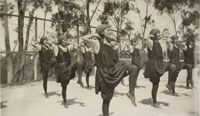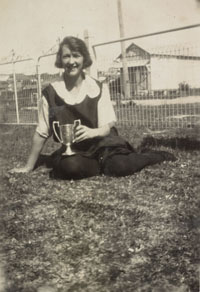Main site navigation
City Girls' Amateur Sports Association


More information about the City Girls' Amateur Sports Association can be found in the AWAP register.
'The Modern Queen of Love and Beauty is not she who sits in a decorated bower, watching the fight, crowning the victor, but she who competes in the Olympiad, often winner of the prize.' So said Margaret Watts, a founding president of the City Girls' Amateur Sports Association (CGASA) in 1928. Edith Robinson, a member of the Anthony Horden Athletics team, had just been selected to compete as Australia's first woman track and field representative at an Olympic Games and Watts was happy to point out that the CGASA had played a role in her getting a ticket to Amsterdam. Robinson had once been a member and had competed in competitions organised through them, as had been Philomena 'Bonnie' Mealing (Exchange Telephone Department), who had been selected in the swimming team. Proudly, Watts proclaimed that 'The establishment of the association has made it possible for Australian women representatives to attend the Olympic Games.'
In 1928, Margaret Watts (née Thorp) along with prominent welfare worker, Eleanor Hinder, and well known radio broadcaster Gwendoline Varley had good reason to regard with pride the achievements of the organisation they helped to establish ten years earlier. In 1918, sport for women was really a school girl and varsity affair, and a relatively elite affair at that. The opportunities available for young women to be involved in organised sport were limited. Several leading business houses, such as Farmers and Anthony Hordens Department Stores, for which Hinder and Watts respectively worked, had their welfare schemes which provided club activities and limited sporting outlets for their employees. Hinder and Watts worried about the girls who worked in smaller organisations and who didn't have the opportunity to participate. The interest shown in sport by the employees in their own organisations indicated to them that something needed to be provided for their benefit. If an independent organisation for girls working in any factory, store, office or domestic employment was established, then, according to Watts, ' all could participate in team games and competition matches, and a community code of health and comradeship could be realized, with a high standard of sport and service, enriching and re-creating the life of the City girl.'
'Re-creating the life of the City girl'; the desire to facilitate this transformation lay at the heart of their efforts. Watts and Hinder were welfare workers with a particular concern about the needs of women in a rapidly industrialising and unbanising Australia. Much had been said about the problems of 'the city boy' in modern times, less regard was paid to the problems of the city girl, especially in relation to vocational training and recreation. 'The girl is regarded as a temporary unit in Industry,' observed Watts, 'her work an incident before marriage. The boy's education, recreation and leisure time pursuits have first place.' The implications of this attitude for the resourcing of women's sport were obvious. 'Sports Grounds for the youngest girls in Industry are rare facts, every available piece of ground being allocated for boys' cricket or football.'
Furthermore, statistical evidence collated by Watts demonstrated that the period between leaving school and marriage, for most Australian women, was a long 'incident'. 'The average girl in Australia marries at twenty-five years of age, which means that she is at work some ten years,' Watts argued. 'When she leaves school and begins to earn her living, what she misses most in her new sphere are the organized games and the team spirit of her school.' Put simply, urban working girls missed companionship. Watts praised the efforts of organisations such as the Young Women's Christian Association (YWCA) and the Girl Guide Movement in filling the void but she felt there was a need for more. 'When one reflects upon how unselfishness, team spirit and other fine qualities are bound up in games, one realizes that sport is a foundation in character,' she observed. Therefore, what the women of Sydney needed was an organisation 'of national purpose for the promotion of health and sport, comradeship and good citizenship.'
This organisation began in 1918 as a meeting of representatives of twelve affiliated business houses and doubled its membership in the space of five years. Annual fees for clubs and members were kept as low as possible, to make the association as inclusive as possible. Apart from organising competitions in the existing sports of hockey, cricket, tennis, rowing, swimming and athletics, the association was instrumental in establishing netball (then basketball) as an organised sport in New South Wales. A health clinic ran out of their offices and members organised an active social program with regular excursions into the country arranged. It even operated as a quasi employment agency. In 1929, the association, in cooperation with the Women's Unemployment Relief Council, opened a registration bureau to provide practical advice and guidance to unemployed girls. The government recognized that the networks the CGASA had developed between business and the community was actually second to none.
Membership also provided girls with the invaluable opportunity of learning organisational and administrative skills. Committee meetings were always well attended, and girls learned how to prepare and present reports and conduct the routine business associated with any business and club, such as minute taking, prioritizing budget items, setting policy, etc. Even this routine business was treated with enthusiasm, 'the reason being' according to Watts, 'that this routine business is pulsating with human interest'. So, apart from the opportunity to be active and make friends, involvement in the CGASA taught women valuable life skills. 'Consequent training in group leadership is of fundamental value,' Watts observed, not only to the individual but to the nation. 'Women's Health is the Nation's Wealth' was the CGASA motto.
One of its most ambitious undertakings was a Gwendoline Varley initiative. In 1922, the CGASA, in cooperation with many of the other important women's organizations of the day, such as the National Council of Women and the Feminst Club, organised what was 'The first Girls Week ever held in Australia'. The programme aimed to show the country the wide range of work and leisure time pursuits that young Australian women were involved in so that 'the part played by the girls in the development of tradition and ideals in Australia' could be better appreciated. The practical aim of the event was to raise funds to support the establishment of a women's sports ground. The event raised a reasonable amount of money, however, "being an organization to promote good health and citizenship, the appeal did not grip the public imagination as a Hospital or Disaster Appeal would have done.' It raised a lot of 'education' interest nonetheless.
The matter of a dedicated sports ground for the women of Sydney was, quite literally, a never-ending concern for the CGASA. Men's and boy's sport was always given priority access to the available playing fields and the high demand for the venues controlled by the Sydney University Women's Sports Association meant that waiting periods, especially on the weekends, were lengthy. Of course, the more women who became involved in sport, the more acute the shortage became. Various campaigns throughout the organisations life were greeted with initial enthusiasm by councils and other authorities with control over public land, but when it came to delivering, there was a large gap between words and actions. In 1922 they received a parcel of land of the Sydney City Council, 'a sandhill' that was still inadequate but a partial achievement, a least. But the battle for access to open space remained unresolved after the CGASA ceased to function.
It is difficult to pinpoint precisely when the CGASA dissolved. Available records suggest that the impact of the depression on this type of organisation, so reliant on discretionary spending for existence, was profound. As low as the registration fees were, they were still too much for many 'city girls' to afford, even those who were employed. The association fell badly behind in payment for venue hire; the goodwill of the Sydney University Women's Sports Association probably saw them stay afloat for longer than they might have otherwise. Fortunately, the structures the association established were strong enough to ensure that organised sport for women in the city of Sydney continued without its guidance. There were enough women trained in the basic of sports administration and active in other more financially sturdy organisations to ensure this was the case.
In it's short but active life, the CGASA played a vital role in establishing organised sport for women and girls outside the school system, and in so doing contributing significantly to the development of sport as a 'democratic' activity in Australian culture. Factory girls played hockey against the students at the University of Sydney; Farmer's office girls joined the cleaners in the basketball team. If an interest in sport is regarded as 'the great leveler' in Australia, then the CGASA clearly had a place in the development of that tradition.
Images
Competition photograph, CGASA; Margaret Watts, President, CGASA
Images are reproduced Courtesy of the Mitchell Library, State Library of New South Wales.